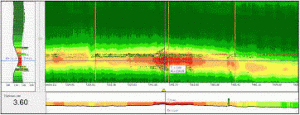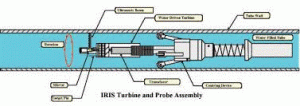The IRIS ultrasonic option is used for the inspection of a wide range of material including ferrous, nonferrous and non-metallic tubing. This technique allows detection and sizing of wall loss and pictorial image shown loss of thickness is from internal or external corrosion, and as the result of corrosion, erosion, wear, pitting, cracking, and baffled cuts.IRIS testing is based on ultrasound and is not impacted for electric properties of material. Only the material characteristics which affect the ultrasound should be taken in consideration. Those are IE: the cleaning of tubing. There should not be any deposition or other dirties inside the tubing which could absorb the ultrasound and avoid the ultrasound to reach the front and back wall of the tubing material.

During the testing the data will be recorded and saved for further evaluation. A lot of information of the condition of the tubes tested will be catered. With IRIS method the typical flaws of tubing can be detected accurately and the type of damages can be evaluated using the data recorded. The testing data includes valuable information about flaws
Separation of ID or OD flaws and damage areas
Depth of the flaws
Flaw types (Both for internal and external corrosion, erosion, vibration impact and wall thinning)
Damage grade: Local or Areal
Location of damage in the direction of the tube length and tube circumference.

After collecting the data from a Heat Exchanger tubing bundle, there is need to locate and mark up all the damaged areas, evaluate the type of damages found and to know the remaining minimum wall thickness of the tubes. It is also very important to locate accurately all different kinds of flaws and to present them in a suitable and informative manner for maintenance personnel.
The tools for doing final conclusions of testing data are:
Flaw depth histograms showing the average grade of wall thickness thinning.
Tube map’s with classifications of tubes according damage grade and/or flaw types
3D presentation of testing results including damaged areas, individual flaws or flaw types.
